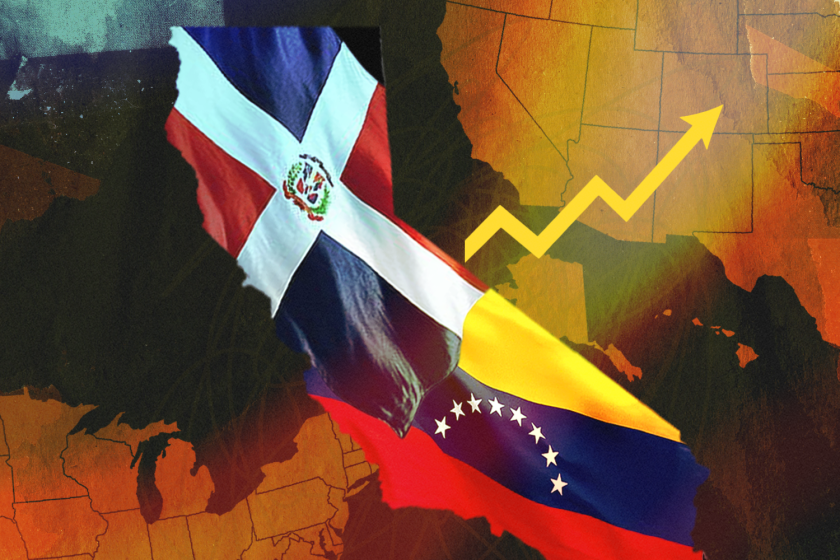
- Share via
A two-year survey of 22 major metro newsrooms found that investigative news reporters and editors are overwhelmingly white.
The survey — conducted by the National Assn. of Hispanic Journalists between 2021 and 2023 and published Wednesday — reveals that 60% of investigative news reporters are white.
Latinos, who are 19% of the U.S. population, made up 13% of investigative reporters. Black reporters made up 9% of investigative teams, compared with 13% of the population. The survey found that 3% of investigative staff members were from the Middle East and North Africa and that fewer than 1% of investigative reporters were Indigenous.
New U.S. census data analyzed by the San Francisco Chronicle show California’s Hispanic populations are changing.
Meanwhile, Asian Americans and Pacific Islanders reporters made up 11% of investigative staff, compared with 6% of the population, according to the report.
“Investigative journalism plays a crucial role in uncovering hidden truths, holding institutions accountable, and driving social change,” the report notes, adding that the imbalances in representation raise concerns about the journalistic ability to “accurately reflect and address the concerns of diverse communities.”
Efforts to survey newsroom leaders on hiring demographics began in December 2021, spearheaded by working journalists who made up the NAHJ Investigative and Data Journalism Task Force.
Representatives from the Asian American Journalists Assn., the National Assn. of Black Journalists and the Indigenous Journalists Assn. were part of the task force.
Politics are changing in the Rio Grande Valley. Is it the breakdown of machine politics, or gerrymandering? A return to true Mexican family values, or a betrayal of them?
The survey and report were overseen by Florida International University associate professor Mercedes Vigón.
The task force looked at investigative journalism units within print, broadcast and online platforms, as well nonprofit and for-profit organizations. Editors were asked to provide information about their unit’s composition, including demographic data such as gender, race, ethnicity and other indicators.
Survey findings revealed even less diversity among editors, showing that more than 75% of editors identified as white, compared with 12% Latino, 5% Black, 4% Asian Americans and Pacific Islanders, and 2% from the Middle East and North Africa.
The report found that representation among investigative reporters and editors was unbalanced between women and men. Women were significantly underrepresented in higher-ranking roles.
It also highlights limited representation of other marginalized groups, such as LGBTQ+ people, suggesting a “lack of inclusivity within investigative journalism units.”
The Justice Department and Consumer Financial Protection Bureaus say Colony Ridge ran a land sales scheme targeting Latinos through false statements and predatory loans.
The report says that “the lack of progress in diversifying investigative teams is a hard conversation for national news leaders.”
Of 45 news organizations repeatedly invited to participate in the survey, only 22 responded, according to the report.
“The struggle was to get newsrooms to answer the survey. That’s why it took us so long,” said Mc Nelly Torres, an editor at the Center for Public Integrity who serves on the NAHJ national board.
“It gets tense because people take it personal,” said Torres, who co-chaired the task force with NAHJ President Yvette Cabrera. “We have to have these tough conversations because if we don’t, things are not going to change.”
Top news organizations including the New York Times and the Washington Post “never answered the survey or responded to our requests for interviews with executives to discuss their diversity hiring record on investigative teams,” the report says.
This is nothing new.
The report points to the News Leaders Assn., which in 2020 halted its annual diversity survey because of a lack of participation from newsrooms.
The last survey conducted by the group, formerly known as the American Society of News Editors, showed that only 17% of national newsrooms bothered to respond to the survey in 2018, followed by a 22% response rate in 2019, according to the report.
The task force said the Los Angeles Times was among the news organizations that filled out the survey and met with task force members to discuss hiring records.
That meeting took place in January 2022, when one of The Times’ six investigative team reporters was a person of color. That’s in a region where people of color are more than half the population. By September of that year, the report noted The Times had announced its addition of three reporters to further diversify its investigative team.
The report included the Associated Press, the Center for Public Integrity and ProPublica as “industry bright spots.”
It highlighted Ron Nixon’s leadership as AP’s global investigative editor, who worked with editors in other departments to give a wider range of reporters a chance to gain investigative experience.
His approach helped “fuel a culture internally where ‘non-investigative’ journalists are able to recognize investigative skills and traits within themselves,” according to the report.
AP leaders also noted the creation of an investigative correspondents program, with a six-month internal fellowship and mentoring. Despite these efforts, AP leadership did not answer the survey, according to the report.
The report credited ProPublica, an investigative newsroom, with having four people of color among the eight managers it hired this year. The newsroom said its staff was 10% Latino and 7% Black. ProPublica has also increased the salary for recipients of its fellowships to $75,000 to try to attract a more diverse group of candidates, according to the report.
At the Center for Public Integrity, Susan Smith Richardson in 2019 became the first Black woman and first person of color to lead the organization, and “set a new tone,” according to the report. It shifted its focus to cover inequality, and now a majority of its staff are people of color, the report said. Management, however, is not as diverse as the staff, according to the report.
Torres lauded the Center for Public Integrity’s “Toxic Labor” reporting as an example of why journalists of color are necessary in investigations. That piece found that immigrant workers in the “booming and loosely regulated disaster restoration industry” are exposed to lethal chemicals that make them sick long after the cleanup.
“One of the reporters on my team speaks Spanish. The fact that she was able to interview these people in their own language, it was huge,” she said of reporter María Inés Zamudio.
Zamudio, with years of experience covering immigrant communities and racial inequalities, spent months reaching out to more than 100 workers by visiting their gathering spaces in churches, food stands, and Latino supermarkets.
She interviewed them about their experiences, gathered and verified supporting documents for the investigation, which was a collaboration between the Center for Public Integrity and Columbia Journalism Investigations.
Torres also speaks from experience. In her nearly 30-year journalism career, she was often the only Latina or person of color in the newsrooms where she’s worked.
“If the media wants to continue to try and evolve with the times, they need to understand that they are missing huge chunk of audiences out there,” Torres said.
More to Read
The Latinx experience chronicled
Get the Latinx Files newsletter for stories that capture the multitudes within our communities.
You may occasionally receive promotional content from the Los Angeles Times.











